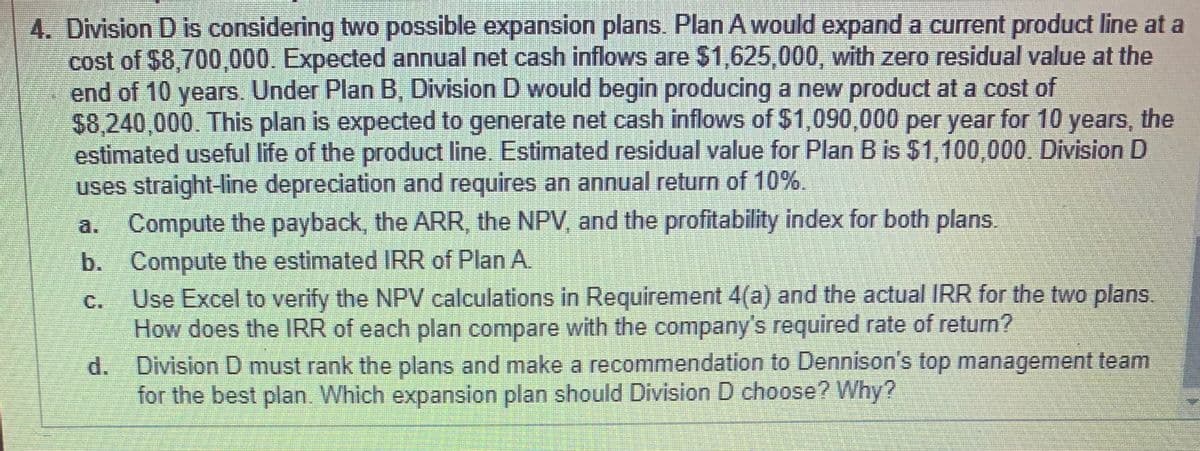4. DivisionD is considering possibi expan Ime al d cost of $8,700,000. Expected annual net cash inflows are $1,625,000, with zero residual value at the end of 10 years. Under Plan B, Division D would begin producing a new product at a cost of $8,240,000. This plan is expected to generate net cash inflows of $1,090,000 per year for 10 estimated useful life of the product line. Estimated residual value for Plan B is $1,100,000. Division D uses straight-line depreciation and requires an annual return of 10%. a. Compute the payback, the ARR, the NPV, and the profitability index for both plans. b. Compute the estimated IRR of Plan A. years, the
4. DivisionD is considering possibi expan Ime al d cost of $8,700,000. Expected annual net cash inflows are $1,625,000, with zero residual value at the end of 10 years. Under Plan B, Division D would begin producing a new product at a cost of $8,240,000. This plan is expected to generate net cash inflows of $1,090,000 per year for 10 estimated useful life of the product line. Estimated residual value for Plan B is $1,100,000. Division D uses straight-line depreciation and requires an annual return of 10%. a. Compute the payback, the ARR, the NPV, and the profitability index for both plans. b. Compute the estimated IRR of Plan A. years, the
Chapter10: Capital Budgeting: Decision Criteria And Real Option
Section10.A: Mutually Exclusive Investments Having Unequal Lives
Problem 2P
Related questions
Question
100%

Transcribed Image Text:4. Division D is considering two possible expansion plans. Plan A would expand a current product line at a
cost of $8,700,000. Expected annual net cash inflows are $1,625,000, with zero residual value at the
end of 10 years. Under Plan B, Division D would begin producing a new product at a cost of
$8,240,000. This plan is expected to generate net cash inflows of $1,090,000 per year for 10 years, the
estimated useful life of the product line. Estimated residual value for Plan B is $1,100,000. Division D
uses straight-line depreciation and requires an annual return of 10%.
Compute the payback, the ARR, the NPV, and the profitability index for both plans.
a.
b. Compute the estimated IRR of Plan A
Use Excel to verify the NPV calculations in Requirement 4(a) and the actual IRR for the two plans.
How does the IRR of each plan compare with the company's required rate of return?
d. Division D must rank the plans and make a recommendation to Dennison's top management team
for the best plan. Which expansion plan should Division D choose? Why?
C.
S.

Transcribed Image Text:Requirement 4. Division D is considering two possible expansion plans. Plan A would expand a current product line at a cost of $8,700,000. Expected annual net cash inflows are $1,625,000, with zero residual value at the end of
10 years. Under Plan B, Division D would begin producing a new product at a cost of $8,240,000. This plan is expected to generate net cash inflows of $1,090,000 per year for 10 years, the estimated useful life of the product line.
Estimated residual value for Plan B is $1,100,000. Division D uses straight-line depreciation and requires an annual return of 10%.
4a. Compute the payback, the ARR, the NPV, and the profitability index for both plans.
Begin by calculating the payback for both plans. (Round your answers to one decimal place, XX)
Payback
Plan A
years
Plan B
years
Expert Solution
This question has been solved!
Explore an expertly crafted, step-by-step solution for a thorough understanding of key concepts.
This is a popular solution!
Trending now
This is a popular solution!
Step by step
Solved in 6 steps with 9 images

Knowledge Booster
Learn more about
Need a deep-dive on the concept behind this application? Look no further. Learn more about this topic, finance and related others by exploring similar questions and additional content below.Recommended textbooks for you

EBK CONTEMPORARY FINANCIAL MANAGEMENT
Finance
ISBN:
9781337514835
Author:
MOYER
Publisher:
CENGAGE LEARNING - CONSIGNMENT

Managerial Accounting
Accounting
ISBN:
9781337912020
Author:
Carl Warren, Ph.d. Cma William B. Tayler
Publisher:
South-Western College Pub

Financial And Managerial Accounting
Accounting
ISBN:
9781337902663
Author:
WARREN, Carl S.
Publisher:
Cengage Learning,

EBK CONTEMPORARY FINANCIAL MANAGEMENT
Finance
ISBN:
9781337514835
Author:
MOYER
Publisher:
CENGAGE LEARNING - CONSIGNMENT

Managerial Accounting
Accounting
ISBN:
9781337912020
Author:
Carl Warren, Ph.d. Cma William B. Tayler
Publisher:
South-Western College Pub

Financial And Managerial Accounting
Accounting
ISBN:
9781337902663
Author:
WARREN, Carl S.
Publisher:
Cengage Learning,


Managerial Accounting: The Cornerstone of Busines…
Accounting
ISBN:
9781337115773
Author:
Maryanne M. Mowen, Don R. Hansen, Dan L. Heitger
Publisher:
Cengage Learning

Fundamentals of Financial Management, Concise Edi…
Finance
ISBN:
9781305635937
Author:
Eugene F. Brigham, Joel F. Houston
Publisher:
Cengage Learning